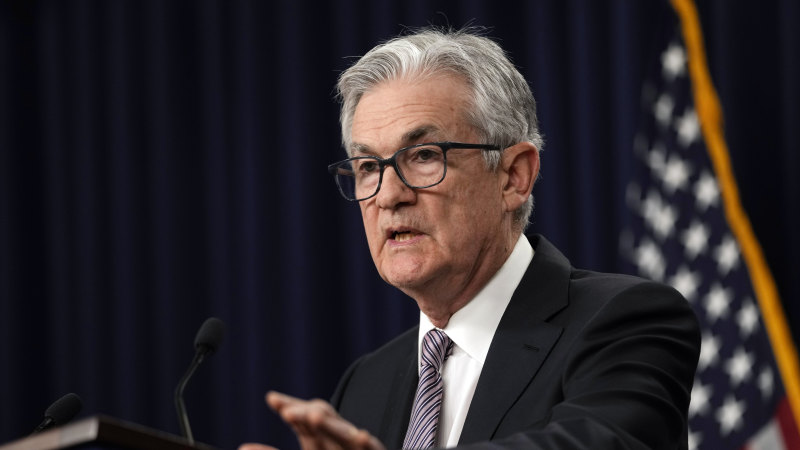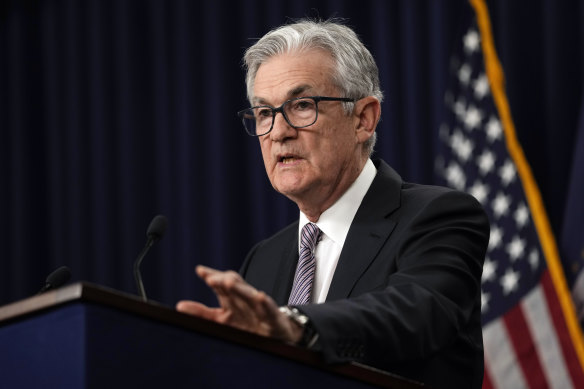Save articles for later
Add articles to your saved list and come back to them any time.
The recent string of bank collapses in the US were at least partly driven by the Federal Reserve Board’s tightening of financial conditions. Now there’s a fear that they could contribute to a broader credit crunch.
The Fed’s twice-yearly financial stability report, released on Monday, warned that ongoing stresses in the banking system could lead to a broader contraction in credit and result in a marked economic slowdown.
“Concerns about the economic outlook, credit quality and funding liquidity could lead banks and other financial institutions to further contract the supply of credit to the economy,” it said.
Federal Reserve chairman Jerome Powell: The US banking crisis is starting to hurt credit availability. Credit: AP
“A sharp contraction in the availability of credit would drive up the cost of funding for businesses and households, potentially resulting in a slowdown of economic activity,” the world’s most powerful central bank warned.
“With a decline in profits of non-financial businesses, financial stress and defaults at some firms could increase, especially in the light of the generally high level of leverage in that sector. Additionally, an associated reduction in investor risk appetite could lead to significant declines in asset prices.”
That is a description of a credit crunch, where the availability of credit dries up and the cost of borrowing money rises. Typically, the most vulnerable sector in a credit squeeze is commercial real estate, which tends to be leveraged, but leveraged financial institutions and sharemarkets are also vulnerable.
“A sharp contraction in the availability of credit would drive up the cost of funding for businesses and households, potentially resulting in a slowdown of economic activity.
As it happens, a separate Fed survey of senior loan officers found that banks tightened lending standards in the first quarter of this year, reducing the size of credit lines and increasing loan covenants and the security for loans. They also raised the cost of the credit they were extending, particularly for riskier loans.
That is occurring, of course, in an environment where the Fed has lifted US rates from near zero a little more than a year ago by about five percentage points, and has been shrinking its own balance sheet at a rate of $US95 billion ($140 billion) a month since last September in its most aggressive tightening of monetary policy in 40 years.
Not surprisingly, the survey also found that demand for credit has been falling, with more than 55 per cent of banks reporting weaker demand from large and mid-sized firms for commercial and industrial loans, the weakest level since the 2008 financial crisis.
Liquidity concerns
Even before the recent failures of the Silicon Valley, Signature and First Republic banks, there was concern that the tightening of monetary policies and signs of liquidity issues in debt markets – even in the normally deep and liquid market for US Treasury securities – would generate financial stress.
The bank collapses, which initially saw a flight of deposits from the smaller banks that provide most of the commercial property finance and much of the funding for small business in the US, have added to the tightening of conditions and the fear that this would lead to problems in the commercial property sector in particular.
The Fed said in its report that “the magnitude of a correction in property values could be sizeable and therefore could lead to credit losses by holders of CRE (commercial real estate) debt”. Many of the respondents to its survey of loan officers also nominate commercial real estate as a possible trigger for systemic risk.
The bank failures were the first sign that the Fed’s policies — which have left banks holding vast quantities of low-yielding fixed-rate securities and mortgages in a rapidly rising rate environment that generates unrealised losses and chokes net interest margins – were opening up cracks in the US financial system.
The fall in asset values for commercial property could be significant, the Fed has warned.Credit: Bloomberg
The real concern is that those cracks could turn into fissures because the pace at which the Fed has tightened conditions hasn’t allowed financial institutions or investors enough time to adjust.
Asset prices – shares and property values – that were inflated by the post-2008 decade and a half of near-zero interest rates have held up despite the tightening cycle and are therefore particularly vulnerable to a credit crunch.
This isn’t just an issue for the US. The Fed’s stability report noted that, if inflationary pressures turn out to be more stubborn than anticipated (which, so far, they have), tighter-than-expected monetary policy could prompt sharp increases in longer-term interest rates and weaken economic growth worldwide.
Australia’s variable home loans
“These developments could strain the debt service capacity of governments, households and businesses abroad, including in emerging market economies that borrow externally,” it said. “Most business loans and, in some countries (like Australia) many residential mortgages have floating interest rates, implying that higher policy rates can quickly increase debt service requirements.”
A sharp rise in interest rates could also lead to increased volatility in global financial markets, stresses to market liquidity and a correction in asset prices.
It also referred to the interconnectedness of the global economy and markets, where stresses in offshore economies can be transmitted to the US through disruptions in asset markets, reduced credit from foreign lenders and the interlinked nature of financial institutions. Equally, of course, stresses within the US economy, financial system and markets can be exported elsewhere.
At this point in a cycle of monetary policy tightening in the US, Europe and other developed economies, including Australia, some challenges were inevitable after such a long period of ultra-loose monetary policies and conditions.
The pace at which conditions have changed was always likely to break things, with the US bank failures the most visible sign that this is occurring.
The cycle hasn’t ended, although it appears to be far closer to its end than its beginning. Inflation rates in the US, Europe and economies like Australia’s remain unpalatably high and therefore monetary conditions will remain tight, and may be tightened further, until there is clear evidence that those inflation rates are in a clear downtrend.
Whether that inevitably involves recessions, or financial market meltdowns, or both, is an open question.
Credit crunches, however, generally aren’t painless and the extent to which loose monetary policies drove increases in global debt and asset prices in the post-2008 era suggests that the abrupt and decisive shift to tight policies over the past year or so could be quite painful.
The Business Briefing newsletter delivers major stories, exclusive coverage and expert opinion. Sign up to get it every weekday morning.
Most Viewed in Business
From our partners
Source: Read Full Article


